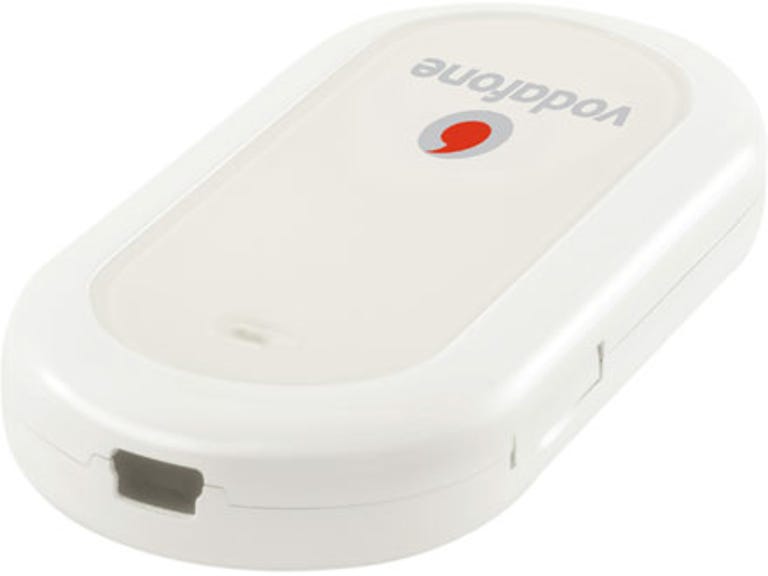 Why You Can Trust CNET
Why You Can Trust CNET Vodafone Mobile Connect 3G HSDPA USB Modem review: Vodafone Mobile Connect 3G HSDPA USB Modem
Vodafone's compact USB modem boosts accessibility to the telco's high-speed 3G mobile network — but the speed can range from over 2Mbps to less than 300Kbps depending on your location.
While the first iteration of 3G and HSDPA modems relied on the PC Card form factor, recent months have seen the arrival of USB alternatives for those users whose laptops are fitted with only an Express Card slot, or in some cases (such as Apple's popular MacBooks) no card slot at all.
The Good
The Bad
The Bottom Line
There's also a bonus in the speed department. Like the USB modem of competitor BigPond Wireless Broadband, Vodafone's little white wireless wonder is rated for HSDPA at 3.6Mbps rather than the 1.8Mbps of its PC Card sibling. The trick is finding out where such speeds are available in Vodafone's admittedly patchy HSDPA network.
Design
Manufactured by Chinese telecoms hardware giant Huawei, Vodafone's USB modem looks more like a soap-on-a-rope, or at least soap-on-a-USB-cable.
The palm-sized modem uses the USB mini-plug most commonly seen on portable USB hard drives and as the combo charge/data connector on smartphones. A 10cm cable connects the modem to the PC, although the bundle includes a more generous 80cm cable with a second USB plug for instances when a single port can't provide enough power to drive the modem.
Features
The modem itself sports precious little in the way of frills and features. Most of the extra goodness in the Vodafone Mobile Connect package comes through the bundled software and the network's active data compression.
As detailed in our earlier review of the Vodafone 3G HSDPA PC Card, this pocket-sized puck works hand-in-hand with Vodafone's network to shrink some files — mainly pictures and documents — to a fraction of their size using on-the-fly compression.
Incoming files are automatically decompressed so there's no need to fiddle with third-party software. Users can also block bandwidth-bloating elements such as video, audio, animation and Web applets.
This enhances speed and makes the most of your monthly download allocation, although it's not ideal for everyone. For example, there's no way to prevent incoming data compression, which some Web developers have reported as an issue when working on the road. (You can, however, disable compression of files sent through your VMC card.)
We were also impressed by the card's software. With SMS and MMS messaging, address book management, connection profiles and a graphical summary of account usage, the console is easily the best client we've seen for any mobile data card.
Performance
As with the latest PC Card, achieving HSDPA speeds with the USB modem relies on the user being within the footprint of what Vodafone calls its "3G broadband" service, which is currently limited to "inner metro" coverage of Sydney and Melbourne.
Outside those areas, as well as inside them if HSDPA signal strength is too weak, the modem falls back to standard 3G and its 384Kbps peak — or all the way back to the painfully slow 60Kbps data stream of GSM.
There's a small bit of silver lining around the HSDPA cloud, and this is that some parts of the high-speed network are already running at the 3.6Mbps rate of the HSDPA 3.6 spec rather than Vodafone's standard 1.8Mbps (HSDPA 1.8). While the PC Card can peddle no faster than 1.8Mbps the USB modem is rated to 3.6Mbps, making it able to deliver higher throughput if you happen to stumble into of those enhanced hotspots.
And "stumble" is the operative word. Although Vodafone says it's flicked the switch on several 3.6Mbps transmitters as part of the HSDPA rollout, the company isn't exactly trumpeting where these souped-up cell stations are. They've admitted that parts of Sydney and Melbourne airport received 3.6Mbps base stations from the get-go, but the rest remains a mystery.
Testing the USB modem in Sydney's CBD and Lower North Shore delivered fairly stable connections over a surprisingly broad range of speeds — sometimes as low as 800Kbps, other times soaring to 1.7Mbps in the same location.
In several instances the USB modem kicked in with a stronger and faster signal than the PC Card when used in the exact same location.
However, Vodafone's biggest disadvantage remains the uneven coverage of its mobile broadband network. There were several times where the modem seemed to endlessly toggle between standard 3G and HSDPA (which the software flags as "3G+"), yet in neither state was the connection usable for anything more than instant messaging. Email downloads stalled because the software couldn't maintain a solid connection with the mail server, while the Web browser sat waiting for sites to respond.
We're sure that users would prefer a reliable connection at even 3G speeds rather than having the odd shot at HSDPA, regardless of whether it's 1.8Mbps or 3.6Mbps.
So while Vodafone's pricing plans are keen and carefully structured — from AU$29.95 per month for 100MB of data (both downloads and uploads are counted) to AU$99.95 for 1GB — road warriors may find that the Next G-based BigPond Wireless Broadband USB Modem is a better bet, if only for its more consistently reliable connection.

